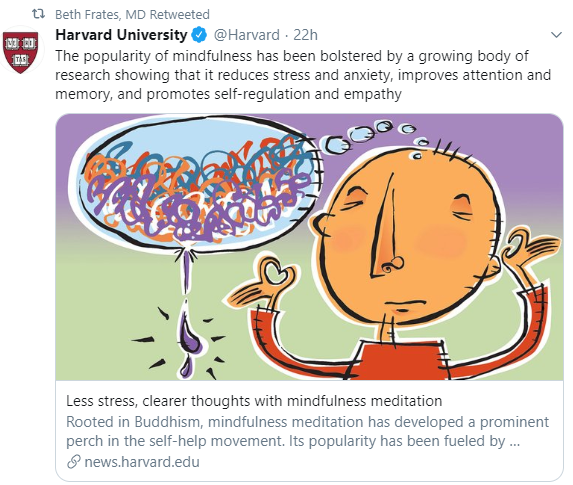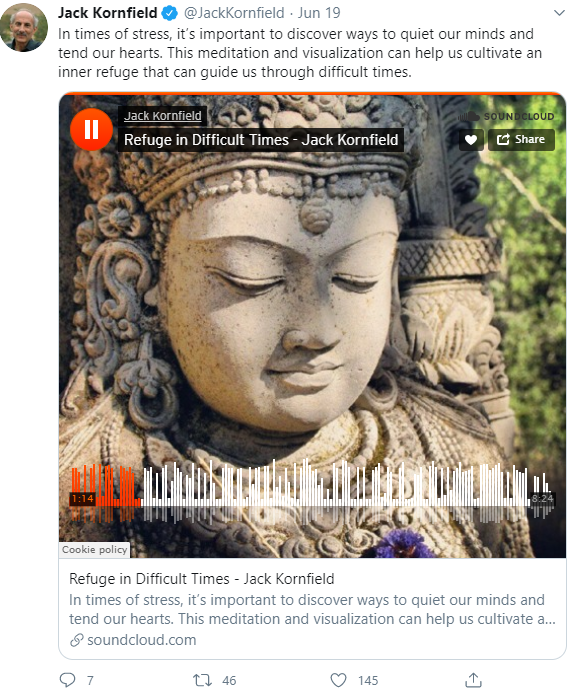This is the final (seventh) session from a One-day Meditation Program for Children and Teenagers with guidance from Ven. Olande Ananda #OlandeAnanda via @TheHappyRajSaga @MindcultureGuru

This is the final (seventh) session from a One-day Meditation Program for Children and Teenagers with guidance from Ven. Olande Ananda #OlandeAnanda via @TheHappyRajSaga @MindcultureGuru

This is the sixth session from a One-day Meditation Program for Children and Teenagers with guidance from Ven. Olande Ananda #OlandeAnanda via @TheHappyRajSaga @MindcultureGuru
Have you heard this:
Yesterday is history, tomorrow is a mystery, today is a gift… which is why we call it the present.
That is exactly why being in the moment matters. That is called mindfulness.
Here are eight accounts on Twitter you must follow if you are serious about being mindful. All of them help you become a better you, in their own ways.
Everyday Mindfulness says that the journey is the destination. And 243,000 followers are on board with that idea.





Charles G. Hanna is the author of Higher: Awaken to a More Fulfilling Life, who focuses on #Mindfulness #Meditation #Addiction #Recovery
You can count on him to share things like this:


Michael Chaskalson’s Twitter feed is not that popular, but it is a hidden gem. A mindfulness trainer, coach, consultant, he is the author of The Mindful Workplace and Mindfulness in Eight Weeks, Mind Time & Mindfulness for Coaches.
You can count on him to follow various media and share the best with you.

Again, take a deep breath!
Wishing you a happy and mindful week and month ahead.
Photo by Daria Shevtsova from Pexels
Photo by Tobias Bjørkli from Pexels
This is the fifth session from a One-day Meditation Program for Children and Teenagers with guidance from Ven. Olande Ananda #OlandeAnanda via @TheHappyRajSaga @MindcultureGuru
Don’t take my word for it. Follow Buddha’s advice and follow “…after observation and analysis, when you find that anything agrees with reason and is conducive to the good and benefit of one and all, then accept it and live up to it.”
Where to begin?
Here’s one of the latest Tweet I found. They are more or less in the same vein.
Here’s what @DalaiLama shared before his birthday about his ‘science guru’ David Bohm. @BohmSociety
This only goes to say that Buddhism isn’t a religion, because it appeals to rational thinking rather than anything else. And seems @DalaiLama agrees. That is why his Twitter account is so popular. Its always positive, rational and uplifting, regardless of your religion.
@Buddhism_Now
Buddhism Now is an online Buddhist magazine based upon the teachings of the Buddha, published from Totnes, England that is followed by over 189,000 people.
Check this out. Heres what it looks like

@LionsRoar
“Lion’s Roar is Foundation is a mission-driven, reader-supported publisher of Buddhist teachings, news, and perspectives.” Here’s the type of thing you will find on their Twitter feed that is followed by over 83,000 people.
@tricyclemag
Tricycle Magazine is a Buddhist Review of teachings, wisdom, and critique where you can sign up for Daily Dharma newsletter.
@FindInnerPeace Buddhist Mediation
on Twitter is a no frills, no visuals account that offers you much food for thought and wisdom.
There are thousands more places you can go to. But these are some of the more reliable sources I turn to.
And of course you can follow us
@TheHappyRajSaga
https://twitter.com/TheHappyRajSaga/status/1284158257674715142

 Meditating Into Happiness is the seventh novel in The Happy Raj Saga Series by Nihal S. Dissanayake. This book will be serialized in the MeditatingIntoHappiness Blog from today.
Meditating Into Happiness is the seventh novel in The Happy Raj Saga Series by Nihal S. Dissanayake. This book will be serialized in the MeditatingIntoHappiness Blog from today.
Previous books in The Happy Raj Saga Series are available on Amazon in print and Kindle versions.
Meditating Into Happiness is not a handbook on meditation. It tries to focus your attention to the practices associated with the theories of meditation.
Professor Happiraja, clad in a flowing white national dress, rose up from his chair and paced towards the podium, after he was invited by the President of the Academic Association of the State Polytechnique to talk to them about Meditation. The invitation had come as a result of their second visit to the Happy Raj Meditation Center. They were convinced about the progress he had made to his Happy Raj during that short period. Professor Happiraja adjusted his microphones to fit his height, looked at the audience, the majority of whom have been working under him in that institution. He flashed a beautiful smile to beautify the auditorium, and spoke in a very clear voice.
“Ladies and Gentlemen,
It was exactly 1210 days ago that I spoke to you at this very auditorium about Happiness. That was the day that I was leaving this institution in search of happiness. I can remember, on that day one of you asked me why I was leaving that high position to move into that wild island, which she had visited on my invitation to spend a weekend with you all. I think you would have realized that it is no longer a wild island now, with sand dunes here and sand dunes there. Some of you told me that things had changed fast, even after the devilish destruction by that tsunami wave a few months after our inauguration. We have rebuilt it with a lot of improvements to withstand the pressure of another high tsunami wave. Your President told me, that your invitation to me to talk to you about meditation was the result of your stay in the Happy Raj Meditation Center for three days.
Ladies and Gentlemen. There are three words that I like to talk to you about. One is meditation. The second is meditating. The third is meditate. Meditation is the theory. And meditate is the verb. How it is done. As regards meditation, the copy of my speech that has already been circulated among you explains what it is. So I am now trying to talk about how we meditate at the Happy Raj Meditation Center.
To summarize my note: There are two main types of meditation we use in the Buddhist system. One we call Samatha meditation. This has the objective of focusing the mind on one concept or a thing in order to aid mental or spiritual development, contemplation or relaxation. The other is called Vipassana. It is looking at something to analyze. You analyze your body. It is necessary for you to strengthen your mind before you can attempt to do any vipassana meditation.
Now I would like to take you to the practices. The most important thing is the environment. It is possible for you to practice meditation even while travelling in a bus or in a train. But for a beginner, it is advisable to have a controlled environment. I have heard of instances, where even the ticking of the clock has become problems. After sometime it is possible for you to have a control of your mind even with your radio on. We have a lady in yellow at the Paradise, she practices meditation while the Satipattana piritha continues on her computer. She is an expert on the Maha Satipattana Sutta and it is played very softly. The idea is that when her breathing exercise breaks, she listens to the Piritha. As far as she is concerned, she has said. “It is successful.”
There was a hand that went up to ask a question.
“You can please ask your question now.”
“Last time when we went to the Paradise, I was talking to a lady who spoke with a foreign accent. She said that she has got into the order because of the confidence she has in the Satipattana Sutta. She was saying that Lord Buddha has said that it is possible for you to be a Stream Winner in seven years or less. I asked her for her name and she said her name with a foreign accent. I heard it as Apemaniyo. I did not want to ask more questions from her because I did not understand her name. Whether it was Sinhala or a foreign name.”
There was laughter all around. Professor Happiraja took a white handkerchief from his pocket and cleaned his eyes. He said, “They call her Apemaniyo because she is the sister of that beauty queen Nangi you would have met there. I will take two minutes to talk to you about Apemaniyo. She was from Guadeloupe, a daughter of a taxi driver. He used to come home drunk in the evenings, and used to have fights with her mother almost every day. One day, after a fight the child had to be hospitalized. Therefore she had been sent to a convent in Paris while she was very small. After schooling she had started working in one of their hospitals. When they knew that she was an ardent worker they had allowed her to get trained as a nurse. After a diploma in nursing from a Nursing School in Paris, she has started working in the same hospital and later had joined a ship that was managed by an anti-terrorist cell. It was there that she had met our beauty queen Nangi who also was a nurse. When Nangi had seen a ghost in her cabin, she had reported it to her Guadeloupian Matron. In their discussion the Matron has confessed that she was utterly scared of the ghosts, and that was the reason why she was looking for a job to get out from the ship. Nangi had said that she was not scared of ghosts, and had given an anti-ghost formula to her Matron.”
Several voices wanted to know, “What was that formula?”
“It is the itipiso gatha. The stanza that has the nine great virtues of Lord Buddha.”
There was another spate of laughter. And the Professor continued. “That made them great friends. When Nangi was sick she had asked the permission of her Matron whether she could get connected to the web, and her Matron wanted to know the reason why. She could not understand why Nangi wanted to meditate. She has explained to Nangi the secret nature of the operations of their ship and that no one was allowed to make any contact with the outside world. However after Nangi explained to her that she wanted to use her sick leave to learn meditation, her Matron had downloaded the website that Nangi had requested. The top brass had studied the website for several hours and had given permission to Nangi to access their servers with a password. Her inquisitiveness to find out what meditation was, had sent her to study the files in the website. This was how her Matron learned about meditation. Her Matron had gone through all the pages in the website and had asked her friend whether the benefits given in the web about meditation were true. Nangi had told her that the advantages had come from the mouth of the great Teacher, Lord Buddha, and whatever he had taught had never been proved wrong.”
To be continued in Part 4 of the serialization.
Copyright © 2014 Nihal S.Dissanayake
All rights reserved.
ISBN 10: 1503127796
ISBN-13: 978-1503127791
Previous books in The Happy Raj Saga Series are available on Amazon in print and Kindle versions.
This is the fourth session from a One-day Meditation Program for Children and Teenagers with guidance from Ven. Olande Ananda #OlandeAnanda via @TheHappyRajSaga @MindcultureGuru


Nirvana is the focus of the new-age novel, From Paradise To Nirvana.
Two young nurses, Nangi and her adopted sister Akki, are preparing a road map to go in search of Nirvana.
The genesis of the project is the strategic plan prepared by Professor Happiraja for the yogis in his Sotapatti Meditation Program in the Happy Raj Meditation Center to expedite their march towards Nirvana. They meet the Professor at the ordination ceremony of their brother, Akura, who gives up his job to follow the meditation program he was promoting.
They request Happiraja to open their male Bastian to women. He agrees and builds the Paradise to house an exclusive center for yoginis.
Akki enters the Paradise and wears the yellow robes to go in search of Nirvana. On an invitation from Akki, Nangi agrees to join her, without wearing the yellow garb, as she has to look after her fatherless baby at her home.
From Paradise to Nirvana is a continuation of THE HAPPY RAJ, the award-winning novel by the same author. It is the fifth novel in the Happy Raj Saga Series, with a common theme and common characters.
The entire saga is based on the words of Lord Buddha:
Happiness is Wealth Supreme.
Billionaire Happiraja is investing his entire fortune into his Meditation Center with the objective of increasing that wealth in the planet earth, through meditation.
Set in the beautiful island of Happy Raj, From Paradise To Nirvana runs on two parallel rails: Emotion-packed family drama of Nangi with her son on her lap, runs forward, backwards and sideways, with pathos, tears, smiles and high aspirations.
On the other rail runs the preparation of the philosophy-packed road map to go in search of Nirvana, amidst disturbances of squirrels and divine beings. Akki Maniyo, born into non-Buddhist family, struggles with the help and blessings of her family to continue with her holy pilgrimage.
When Nangi plans to build a temple in their own estate, Akki Maniyo donates her savings to finance the cost of all constructions. Happiraja finances all the furniture and equipment. A divine being makes available bone relics of Lord Buddha to her temple. Nangi believes that her plans to be a Stream Winner will be successful.
After completing their first seminar for women in the temple Akki Maniyo steps into their family home to see her old playmate, Prince, who had been kept away from her after the debacle on the day Akki Maniyo, took her precepts.
Fully committed to the joint plan, Nangi continues with her research into the Cannons of Buddhism, and suddenly stumbles upon a section, which confirms that both sisters have qualified [Chula Sotapanna] to enter into the holy path and would certainly reach Nirvana. This makes Akki Maniyo rev up her engines to finish the pilgrimage within five years as planned. This novel uses an easy to read style, dotted with dialogues, simple words, and common phrases, to explain the philosophy of Buddhism on which it is based.
From Paradise to Nirvana suits best those young women who seek to increase their happiness levels through meditation.
Happy Raj Saga Series is a set of six novels with common characters and a common theme: Happiness is wealth supreme.
The original novel, The Happy Raj, is the story of enigmatic billionaire Professor Happiraja who invests his billions in a beautiful island to build his dream project: The Kingdom of Happiness. The entire series revolves around Professor Happiraja, and his super meditation center where he succeeds in being a Stream Winner.
His Sotapatti Meditation Program offered free in that environment has the objective of helping those who are committed to move up to be a Sotapanna.
The six novels in the Happy Raj Saga Series are:

Mettanisansa sutta talks about eleven advantages of cultivating loving kindness.

1. You sleep in comfort.
2. You wake up in comfort.
3, You do not see evil dreams.
4. You become dear to other human beings.
5. You become dear to non-human beings.
6. You receive the protection from devas (gods/deities).
7. Fire, poison, and weapons cannot touch you.
8. You are able to concentrate quickly.
9. Your countenance becomes serene.
10. You can die without being confused of mind.
11. If you fail to attain arahantship (the highest sanctity) here and now,
you will be reborn in the brahma-world.
Says the Buddha:
“These eleven advantages, monks, are to be expected from the release of heart by familiarizing oneself with thoughts of loving-kindness, by the cultivation of loving-kindness, by constantly increasing these thoughts, by regarding loving-kindness as a vehicle (of expression), and also as something to be treasured, by living in conformity with these thoughts, by putting these ideas into practice and by establishing them.”
Photo by Wallace Chuck from Pexels
Photo by Lucas Ricardo Ignacio from Pexels
This is the third session from a One-day Meditation Program for Children and Teenagers with guidance from Ven. Olande Ananda #OlandeAnanda via @TheHappyRajSaga @MindcultureGuru